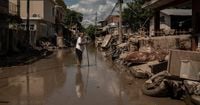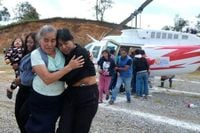Last week, a series of torrential rains unleashed catastrophic flooding and landslides across central and eastern Mexico, leaving a trail of devastation that has shaken communities and tested the nation’s emergency response systems. As of October 18, 2025, at least 72 people have been confirmed dead, with 48 still missing, according to a government update reported by BERNAMA-Sputnik/RIA Novosti. The hardest-hit regions—Veracruz, Hidalgo, and Puebla—are grappling with the aftermath as thousands remain displaced, entire villages have been cut off, and the full extent of the disaster is still unfolding.
The crisis began when the convergence of two tropical storms off Mexico’s western coast struck at the tail end of an unusually heavy rainy season. This meteorological collision triggered relentless downpours, causing rivers to burst their banks and hillsides to crumble, resulting in landslides that isolated more than 300 communities from the outside world, as reported by East Idaho News. In the state of Veracruz alone, rainfall reached a staggering 24 inches in just four days—three times what had been forecasted. The Cazones River in Poza Rica, a small working-class city, surged so rapidly that water levels climbed 13 feet in some neighborhoods, leaving residents with virtually no time to react.
“The alert arrived when the wave was already on top of you,” said 78-year-old Adán González Ortega, a Poza Rica resident, in an interview with The New York Times. He managed to reach his sister’s house as the water rose to his waist, but not everyone was so fortunate. Many residents, especially those living along the riverbanks, only had time to shout warnings to neighbors and scramble for higher ground. The village of Chapula, home to about 400 people, was nearly wiped out by what survivors described as a "crushing wall of water." Stephanie Ramírez, a 21-year-old evacuee, recounted to East Idaho News, “There’s nothing left. It wiped out houses, it wiped out the bridge, it wiped out everything. The only thing left standing was the church and the warehouse where we were seeking refuge.”
The scale of destruction is staggering. In Hidalgo, about 100,000 homes were damaged or destroyed, while in Veracruz, more than 300,000 people were affected. The government’s figures show that the death toll includes 32 in Veracruz, 21 in Hidalgo, 18 in Puebla, and one in Queretaro. Dozens remain missing, and officials warn that the true scale of the tragedy in remote towns—some with populations as small as a few hundred—remains unknown.
Thousands of soldiers, rescue workers, and volunteers have been mobilized. Over 12,000 servicemen and rescue workers are involved in the response, according to the Mexican government. Their efforts have focused on reopening roads blocked by landslides, repairing washed-out bridges, and delivering emergency supplies to isolated communities. Helicopters and private air bridges have been used to evacuate the most vulnerable, while health teams have begun fumigating flooded areas to prevent outbreaks of dengue and other mosquito-borne diseases. In Poza Rica, floodwaters left behind a black, oily residue believed to have originated from nearby oil and gas installations, coating homes and trees and raising further health concerns.
President Claudia Sheinbaum, who has been in office for just a year and is a trained scientist with a background in climate change, has been at the forefront of the response. She visited the flooded areas this week, promising that “the government will spare no expense during this emergency.” Her administration has pledged to focus more on prevention involving hurricanes and rains, especially in the wake of Hurricane Otis’s devastation in Acapulco in late 2023. Yet, Sheinbaum stopped short of explicitly mentioning climate change in her public addresses, even as researchers and meteorologists pointed to it as a driving force behind the increasing frequency and severity of such disasters.
Christian Domínguez, a researcher at the Atmosphere and Climate Change Institute at Mexico’s National Autonomous University, stressed to the Associated Press that “we’re being more and more affected by these phenomena and we can’t go on like this, failing by not knowing what to do and not having … adequate warning.” She highlighted technological gaps in Mexico’s weather monitoring systems, such as insufficient river level instrumentation and a lack of weather radars, which hamper efforts to provide detailed hydrological forecasts and timely warnings.
In the days leading up to the disaster, authorities had forecast nearly eight inches of rain in Veracruz—enough to warrant serious preparation—but the actual rainfall far exceeded predictions. As Domínguez observed, “the original forecast should have been enough for residents and authorities to get organized,” but many began to flee only after floodwaters were already inundating their homes. Some residents, like those in Poza Rica, said warnings came too late, while others simply could not believe the situation would become so dire.
The government’s response has drawn both praise and criticism. Sheinbaum’s visible presence in affected areas has been contrasted with her predecessor, Andrés Manuel López Obrador, who was widely criticized for his absence after Hurricane Otis. However, the disaster has also put intense pressure on her administration, especially in light of a disaster fund slashed by the previous president over corruption claims, a move that some now blame for the slow response. Videos circulating on social media show residents confronting Sheinbaum and expressing frustration over delayed assistance. “They didn’t say that anything like this was going to happen,” González told The New York Times, standing in the mud outside his flooded home.
Despite these challenges, many have praised the efforts of local residents and neighbors who were often the first to help. In Chapula, for example, residents organized their own rescue, calling relatives in the United States to arrange evacuations and forming private air bridges to ferry people to safety. Others walked for hours, carrying basic goods to neighboring villages still cut off from aid.
As the nation begins the slow process of recovery and reconstruction, the disaster has underscored the urgent need for improved severe weather warnings, better prevention strategies, and greater public education about the risks posed by climate change. Carlos Valdés, former head of Mexico’s National Disaster Prevention Center, told the Associated Press, “The first thing we have to do is recognize that there is a change … the atypical is now the most typical.”
For many in the affected regions, the road ahead is daunting. Entire neighborhoods have been left with nothing but mud and debris. “We have to start from scratch,” said Eduardo Cerecedo, a Poza Rica resident. Yet, amid the loss, stories of resilience and solidarity abound, as communities come together to rebuild and demand a safer, more prepared future.

